| Listing 1 - 10 of 44 | << page >> |
Sort by
|
Book
ISBN: 069122014X Year: 2005 Publisher: Princeton, New Jersey : Princeton University Press,
Abstract | Keywords | Export | Availability | Bookmark
 Loading...
Loading...Choose an application
- Reference Manager
- EndNote
- RefWorks (Direct export to RefWorks)
So-called classical logic--the logic developed in the early twentieth century by Gottlob Frege, Bertrand Russell, and others--is computationally the simplest of the major logics, and it is adequate for the needs of most mathematicians. But it is just one of the many kinds of reasoning in everyday thought. Consequently, when presented by itself--as in most introductory texts on logic--it seems arbitrary and unnatural to students new to the subject. In Classical and Nonclassical Logics, Eric Schechter introduces classical logic alongside constructive, relevant, comparative, and other nonclassical logics. Such logics have been investigated for decades in research journals and advanced books, but this is the first textbook to make this subject accessible to beginners. While presenting an assortment of logics separately, it also conveys the deeper ideas (such as derivations and soundness) that apply to all logics. The book leads up to proofs of the Disjunction Property of constructive logic and completeness for several logics. The book begins with brief introductions to informal set theory and general topology, and avoids advanced algebra; thus it is self-contained and suitable for readers with little background in mathematics. It is intended primarily for undergraduate students with no previous experience of formal logic, but advanced students as well as researchers will also profit from this book.
Mathematics --- Proposition (Logic) --- Philosophy. --- Ackermann constants. --- Banach-Tarski paradox. --- Brouwer. --- Eubulides paradox. --- Herbrand Principle. --- Heyting algebras. --- Jarden's Proof. --- adequacy. --- algorithm. --- ambiguity. --- binary operator. --- certification. --- chain order. --- comparative logic. --- consequence. --- derivation. --- detachment. --- discrete topology. --- equivalence class. --- excluded middle. --- extremes. --- functional interpretation. --- fuzzy logics. --- generated topology. --- homomorphism. --- idempotency. --- implication. --- informal set theory. --- lower set topology. --- monotone. --- natural numbers. --- parentheses. --- quantifier. --- semantic. --- symbol sharing. --- tautology.
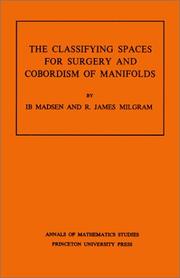
ISBN: 0691082251 069108226X 1400881471 Year: 1979 Publisher: Princeton, N. J.
Abstract | Keywords | Export | Availability | Bookmark
 Loading...
Loading...Choose an application
- Reference Manager
- EndNote
- RefWorks (Direct export to RefWorks)
Beginning with a general discussion of bordism, Professors Madsen and Milgram present the homotopy theory of the surgery classifying spaces and the classifying spaces for the various required bundle theories. The next part covers more recent work on the maps between these spaces and the properties of the PL and Top characteristic classes, and includes integrality theorems for topological and PL manifolds. Later chapters treat the integral cohomology of BPL and Btop. The authors conclude with a discussion of the PL and topological cobordism rings and a construction of the torsion-free generators.
Algebraic topology --- 515.16 --- Classifying spaces --- Cobordism theory --- Manifolds (Mathematics) --- Surgery (Topology) --- Differential topology --- Homotopy equivalences --- Topology --- Geometry, Differential --- Spaces, Classifying --- Fiber bundles (Mathematics) --- Fiber spaces (Mathematics) --- Topology of manifolds --- Classifying spaces. --- Cobordism theory. --- Manifolds (Mathematics). --- Surgery (Topology). --- 515.16 Topology of manifolds --- Bijection. --- Calculation. --- Characteristic class. --- Classification theorem. --- Classifying space. --- Closed manifold. --- Cobordism. --- Coefficient. --- Cohomology. --- Commutative diagram. --- Commutative property. --- Complex projective space. --- Connected sum. --- Corollary. --- Cup product. --- Diagram (category theory). --- Differentiable manifold. --- Disjoint union. --- Disk (mathematics). --- Effective method. --- Eilenberg–Moore spectral sequence. --- Elaboration. --- Equivalence class. --- Exact sequence. --- Exterior algebra. --- Fiber bundle. --- Fibration. --- Function composition. --- H-space. --- Homeomorphism. --- Homomorphism. --- Homotopy fiber. --- Homotopy group. --- Homotopy. --- Hopf algebra. --- Iterative method. --- Loop space. --- Manifold. --- Massey product. --- N-sphere. --- Normal bundle. --- Obstruction theory. --- Pairing. --- Permutation. --- Piecewise linear manifold. --- Piecewise linear. --- Polynomial. --- Prime number. --- Projective space. --- Sequence. --- Simply connected space. --- Special case. --- Spin structure. --- Steenrod algebra. --- Subset. --- Summation. --- Tensor product. --- Theorem. --- Topological group. --- Topological manifold. --- Topology. --- Total order. --- Variétés topologiques --- Topologie differentielle
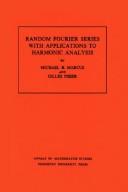
ISBN: 0691082898 0691082928 1400881536 Year: 1981 Volume: no. 101 Publisher: Princeton (N.J.): Princeton university press
Abstract | Keywords | Export | Availability | Bookmark
 Loading...
Loading...Choose an application
- Reference Manager
- EndNote
- RefWorks (Direct export to RefWorks)
In this book the authors give the first necessary and sufficient conditions for the uniform convergence a.s. of random Fourier series on locally compact Abelian groups and on compact non-Abelian groups. They also obtain many related results. For example, whenever a random Fourier series converges uniformly a.s. it also satisfies the central limit theorem. The methods developed are used to study some questions in harmonic analysis that are not intrinsically random. For example, a new characterization of Sidon sets is derived.The major results depend heavily on the Dudley-Fernique necessary and sufficient condition for the continuity of stationary Gaussian processes and on recent work on sums of independent Banach space valued random variables. It is noteworthy that the proofs for the Abelian case immediately extend to the non-Abelian case once the proper definition of random Fourier series is made. In doing this the authors obtain new results on sums of independent random matrices with elements in a Banach space. The final chapter of the book suggests several directions for further research.
Harmonic analysis. Fourier analysis --- Fourier series. --- Harmonic analysis. --- Fourier, Séries de --- Analyse harmonique --- 517.518.4 --- Fourier series --- Harmonic analysis --- Analysis (Mathematics) --- Functions, Potential --- Potential functions --- Banach algebras --- Calculus --- Mathematical analysis --- Mathematics --- Bessel functions --- Harmonic functions --- Time-series analysis --- Fourier integrals --- Series, Fourier --- Series, Trigonometric --- Trigonometric series --- Fourier analysis --- 517.518.4 Trigonometric series --- Fourier, Séries de --- Abelian group. --- Almost periodic function. --- Almost surely. --- Banach space. --- Big O notation. --- Cardinality. --- Central limit theorem. --- Circle group. --- Coefficient. --- Commutative property. --- Compact group. --- Compact space. --- Complex number. --- Continuous function. --- Corollary. --- Discrete group. --- Equivalence class. --- Existential quantification. --- Finite group. --- Gaussian process. --- Haar measure. --- Independence (probability theory). --- Inequality (mathematics). --- Integer. --- Irreducible representation. --- Non-abelian group. --- Non-abelian. --- Normal distribution. --- Orthogonal group. --- Orthogonal matrix. --- Probability distribution. --- Probability measure. --- Probability space. --- Probability. --- Random function. --- Random matrix. --- Random variable. --- Rate of convergence. --- Real number. --- Ring (mathematics). --- Scientific notation. --- Set (mathematics). --- Slepian's lemma. --- Small number. --- Smoothness. --- Stationary process. --- Subgroup. --- Subset. --- Summation. --- Theorem. --- Uniform convergence. --- Unitary matrix. --- Variance.
Book
ISBN: 1400853079 9781400853076 Year: 2014 Publisher: Princeton, NJ
Abstract | Keywords | Export | Availability | Bookmark
 Loading...
Loading...Choose an application
- Reference Manager
- EndNote
- RefWorks (Direct export to RefWorks)
Mathematical Notes, 29Originally published in 1983.The Princeton Legacy Library uses the latest print-on-demand technology to again make available previously out-of-print books from the distinguished backlist of Princeton University Press. These editions preserve the original texts of these important books while presenting them in durable paperback and hardcover editions. The goal of the Princeton Legacy Library is to vastly increase access to the rich scholarly heritage found in the thousands of books published by Princeton University Press since its founding in 1905.
Differential equations, Elliptic --- Schrödinger operator. --- Eigenfunctions. --- Functions, Proper --- Proper functions --- Boundary value problems --- Differential equations --- Integral equations --- Operator, Schrödinger --- Differential operators --- Quantum theory --- Schrödinger equation --- Numerical solutions. --- Numerical solutions --- Approximation. --- Ball (mathematics). --- Bounded function. --- Center of mass. --- Coefficient. --- Compact space. --- Complex number. --- Continuous function (set theory). --- Continuous function. --- Discrete spectrum. --- Distribution (mathematics). --- Eigenfunction. --- Eigenvalues and eigenvectors. --- Elliptic operator. --- Equation. --- Equivalence class. --- Essential spectrum. --- Estimation. --- Existential quantification. --- Exponential decay. --- Function space. --- Fundamental theorem of calculus. --- Geometry. --- Ground state. --- Infimum and supremum. --- Lebesgue measure. --- Open set. --- Pointwise. --- Quadratic form. --- Quantity. --- Restriction (mathematics). --- Riemannian manifold. --- Robert Langlands. --- Schrödinger equation. --- Self-adjoint operator. --- Self-adjoint. --- Smoothness. --- Special case. --- Subset. --- Support (mathematics). --- Theorem. --- Upper and lower bounds. --- Weak solution. --- Without loss of generality.
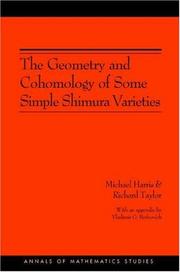
ISBN: 1400837200 9781400837205 0691090920 9780691090924 Year: 2001 Publisher: Princeton, NJ
Abstract | Keywords | Export | Availability | Bookmark
 Loading...
Loading...Choose an application
- Reference Manager
- EndNote
- RefWorks (Direct export to RefWorks)
This book aims first to prove the local Langlands conjecture for GLn over a p-adic field and, second, to identify the action of the decomposition group at a prime of bad reduction on the l-adic cohomology of the "simple" Shimura varieties. These two problems go hand in hand. The results represent a major advance in algebraic number theory, finally proving the conjecture first proposed in Langlands's 1969 Washington lecture as a non-abelian generalization of local class field theory. The local Langlands conjecture for GLn(K), where K is a p-adic field, asserts the existence of a correspondence, with certain formal properties, relating n-dimensional representations of the Galois group of K with the representation theory of the locally compact group GLn(K). This book constructs a candidate for such a local Langlands correspondence on the vanishing cycles attached to the bad reduction over the integer ring of K of a certain family of Shimura varieties. And it proves that this is roughly compatible with the global Galois correspondence realized on the cohomology of the same Shimura varieties. The local Langlands conjecture is obtained as a corollary. Certain techniques developed in this book should extend to more general Shimura varieties, providing new instances of the local Langlands conjecture. Moreover, the geometry of the special fibers is strictly analogous to that of Shimura curves and can be expected to have applications to a variety of questions in number theory.
Mathematics --- Shimura varieties. --- MATHEMATICS / Number Theory. --- Varieties, Shimura --- Arithmetical algebraic geometry --- Math --- Science --- Abelian variety. --- Absolute value. --- Algebraic group. --- Algebraically closed field. --- Artinian. --- Automorphic form. --- Base change. --- Bijection. --- Canonical map. --- Codimension. --- Coefficient. --- Cohomology. --- Compactification (mathematics). --- Conjecture. --- Corollary. --- Dimension (vector space). --- Dimension. --- Direct limit. --- Division algebra. --- Eigenvalues and eigenvectors. --- Elliptic curve. --- Embedding. --- Equivalence class. --- Equivalence of categories. --- Existence theorem. --- Field of fractions. --- Finite field. --- Function field. --- Functor. --- Galois cohomology. --- Galois group. --- Generic point. --- Geometry. --- Hasse invariant. --- Infinitesimal character. --- Integer. --- Inverse system. --- Isomorphism class. --- Lie algebra. --- Local class field theory. --- Maximal torus. --- Modular curve. --- Moduli space. --- Monic polynomial. --- P-adic number. --- Prime number. --- Profinite group. --- Residue field. --- Ring of integers. --- Separable extension. --- Sheaf (mathematics). --- Shimura variety. --- Simple group. --- Special case. --- Spectral sequence. --- Square root. --- Subset. --- Tate module. --- Theorem. --- Transcendence degree. --- Unitary group. --- Valuative criterion. --- Variable (mathematics). --- Vector space. --- Weil group. --- Weil pairing. --- Zariski topology.
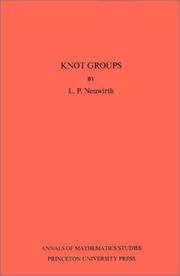
ISBN: 0691079919 1400882036 9780691079912 Year: 1965 Volume: 56 Publisher: Princeton, N. J.
Abstract | Keywords | Export | Availability | Bookmark
 Loading...
Loading...Choose an application
- Reference Manager
- EndNote
- RefWorks (Direct export to RefWorks)
The description for this book, Knot Groups. Annals of Mathematics Studies. (AM-56), Volume 56, will be forthcoming.
Topology --- 512 --- Algebra --- 512 Algebra --- Knot theory. --- Knots (Topology) --- Low-dimensional topology --- Abelian group. --- Alexander duality. --- Alexander polynomial. --- Algebraic theory. --- Algorithm. --- Analytic continuation. --- Associative property. --- Automorphism. --- Axiom. --- Bijection. --- Binary relation. --- Calculation. --- Central series. --- Characterization (mathematics). --- Cobordism. --- Coefficient. --- Cohomology. --- Combinatorics. --- Commutator subgroup. --- Complete theory. --- Computation. --- Conjugacy class. --- Conjugate element (field theory). --- Connected space. --- Connectedness. --- Coprime integers. --- Coset. --- Covering space. --- Curve. --- Cyclic group. --- Dehn's lemma. --- Determinant. --- Diagonalization. --- Diagram (category theory). --- Dimension. --- Direct product. --- Equivalence class. --- Equivalence relation. --- Euclidean space. --- Euler characteristic. --- Existential quantification. --- Fiber bundle. --- Finite group. --- Finitely generated module. --- Frattini subgroup. --- Free abelian group. --- Fundamental group. --- Geometry. --- Group ring. --- Group theory. --- Group with operators. --- Hausdorff space. --- Homeomorphism. --- Homology (mathematics). --- Homomorphism. --- Homotopy group. --- Homotopy. --- Identity matrix. --- Inner automorphism. --- Interior (topology). --- Intersection number (graph theory). --- Knot group. --- Linear combination. --- Manifold. --- Mathematical induction. --- Monomorphism. --- Morphism. --- Morse theory. --- Natural transformation. --- Non-abelian group. --- Normal subgroup. --- Orientability. --- Permutation. --- Polynomial. --- Presentation of a group. --- Principal ideal domain. --- Principal ideal. --- Root of unity. --- Semigroup. --- Simplicial complex. --- Simply connected space. --- Special case. --- Square matrix. --- Subgroup. --- Subset. --- Summation. --- Theorem. --- Three-dimensional space (mathematics). --- Topological space. --- Topology. --- Torus knot. --- Transfinite number. --- Trefoil knot. --- Trichotomy (mathematics). --- Trivial group. --- Triviality (mathematics). --- Two-dimensional space. --- Unit vector. --- Wreath product.
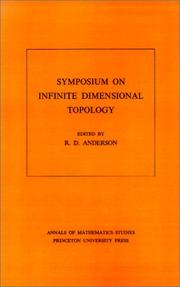
ISBN: 0691080879 1400881404 9780691080871 Year: 1972 Volume: 69 Publisher: Princeton, N.J.
Abstract | Keywords | Export | Availability | Bookmark
 Loading...
Loading...Choose an application
- Reference Manager
- EndNote
- RefWorks (Direct export to RefWorks)
In essence the proceedings of the 1967 meeting in Baton Rouge, the volume offers significant papers in the topology of infinite dimensional linear spaces, fixed point theory in infinite dimensional spaces, infinite dimensional differential topology, and infinite dimensional pointset topology. Later results of the contributors underscore the basic soundness of this selection, which includes survey and expository papers, as well as reports of continuing research.
Topology --- Differential geometry. Global analysis --- Differential topology --- Functional analysis --- Congresses --- Analyse fonctionnnelle --- Geometry, Differential --- Anderson's theorem. --- Annihilator (ring theory). --- Automorphism. --- Baire measure. --- Banach algebra. --- Banach manifold. --- Banach space. --- Bounded operator. --- Cartesian product. --- Characterization (mathematics). --- Cohomology. --- Compact space. --- Complement (set theory). --- Complete metric space. --- Connected space. --- Continuous function. --- Convex set. --- Coset. --- Critical point (mathematics). --- Diagram (category theory). --- Differentiable manifold. --- Differential topology. --- Dimension (vector space). --- Dimension. --- Dimensional analysis. --- Dual space. --- Duality (mathematics). --- Endomorphism. --- Equivalence class. --- Euclidean space. --- Existential quantification. --- Explicit formulae (L-function). --- Exponential map (Riemannian geometry). --- Fixed-point theorem. --- Fréchet derivative. --- Fréchet space. --- Fuchsian group. --- Function space. --- Fundamental class. --- Haar measure. --- Hessian matrix. --- Hilbert space. --- Homeomorphism. --- Homology (mathematics). --- Homotopy group. --- Homotopy. --- Inclusion map. --- Infimum and supremum. --- Lebesgue space. --- Lefschetz fixed-point theorem. --- Limit point. --- Linear space (geometry). --- Locally convex topological vector space. --- Loop space. --- Mathematical optimization. --- Measure (mathematics). --- Metric space. --- Module (mathematics). --- Natural topology. --- Neighbourhood (mathematics). --- Normal space. --- Normed vector space. --- Open set. --- Ordinal number. --- Paracompact space. --- Partition of unity. --- Path space. --- Product topology. --- Quantifier (logic). --- Quotient space (linear algebra). --- Quotient space (topology). --- Radon measure. --- Reflexive space. --- Representation theorem. --- Riemannian manifold. --- Schauder fixed point theorem. --- Sign (mathematics). --- Simply connected space. --- Space form. --- Special case. --- Stiefel manifold. --- Strong operator topology. --- Subcategory. --- Submanifold. --- Subset. --- Tangent space. --- Teichmüller space. --- Theorem. --- Topological space. --- Topological vector space. --- Topology. --- Transfinite induction. --- Transfinite. --- Transversal (geometry). --- Transversality theorem. --- Tychonoff cube. --- Union (set theory). --- Unit sphere. --- Weak topology. --- Weakly compact. --- Differential topology - Congresses --- Functional analysis - Congresses --- Topology - Congresses --- Analyse fonctionnelle.
Book
ISBN: 9780691140490 9780691140483 0691140480 0691140499 9786612644955 1400830559 1282644955 9781400830558 9781282644953 6612644958 Year: 2009 Volume: 170 Publisher: Princeton Princeton University Press
Abstract | Keywords | Export | Availability | Bookmark
 Loading...
Loading...Choose an application
- Reference Manager
- EndNote
- RefWorks (Direct export to RefWorks)
Higher category theory is generally regarded as technical and forbidding, but part of it is considerably more tractable: the theory of infinity-categories, higher categories in which all higher morphisms are assumed to be invertible. In Higher Topos Theory, Jacob Lurie presents the foundations of this theory, using the language of weak Kan complexes introduced by Boardman and Vogt, and shows how existing theorems in algebraic topology can be reformulated and generalized in the theory's new language. The result is a powerful theory with applications in many areas of mathematics. The book's first five chapters give an exposition of the theory of infinity-categories that emphasizes their role as a generalization of ordinary categories. Many of the fundamental ideas from classical category theory are generalized to the infinity-categorical setting, such as limits and colimits, adjoint functors, ind-objects and pro-objects, locally accessible and presentable categories, Grothendieck fibrations, presheaves, and Yoneda's lemma. A sixth chapter presents an infinity-categorical version of the theory of Grothendieck topoi, introducing the notion of an infinity-topos, an infinity-category that resembles the infinity-category of topological spaces in the sense that it satisfies certain axioms that codify some of the basic principles of algebraic topology. A seventh and final chapter presents applications that illustrate connections between the theory of higher topoi and ideas from classical topology.
Algebraic geometry --- Topology --- Toposes --- Categories (Mathematics) --- Categories (Mathematics). --- Toposes. --- Algebra --- Mathematics --- Physical Sciences & Mathematics --- Category theory (Mathematics) --- Topoi (Mathematics) --- Algebra, Homological --- Algebra, Universal --- Group theory --- Logic, Symbolic and mathematical --- Functor theory --- Adjoint functors. --- Associative property. --- Base change map. --- Base change. --- CW complex. --- Canonical map. --- Cartesian product. --- Category of sets. --- Category theory. --- Coequalizer. --- Cofinality. --- Coherence theorem. --- Cohomology. --- Cokernel. --- Commutative property. --- Continuous function (set theory). --- Contractible space. --- Coproduct. --- Corollary. --- Derived category. --- Diagonal functor. --- Diagram (category theory). --- Dimension theory (algebra). --- Dimension theory. --- Dimension. --- Enriched category. --- Epimorphism. --- Equivalence class. --- Equivalence relation. --- Existence theorem. --- Existential quantification. --- Factorization system. --- Functor category. --- Functor. --- Fundamental group. --- Grothendieck topology. --- Grothendieck universe. --- Group homomorphism. --- Groupoid. --- Heyting algebra. --- Higher Topos Theory. --- Higher category theory. --- Homotopy category. --- Homotopy colimit. --- Homotopy group. --- Homotopy. --- I0. --- Inclusion map. --- Inductive dimension. --- Initial and terminal objects. --- Inverse limit. --- Isomorphism class. --- Kan extension. --- Limit (category theory). --- Localization of a category. --- Maximal element. --- Metric space. --- Model category. --- Monoidal category. --- Monoidal functor. --- Monomorphism. --- Monotonic function. --- Morphism. --- Natural transformation. --- Nisnevich topology. --- Noetherian topological space. --- Noetherian. --- O-minimal theory. --- Open set. --- Power series. --- Presheaf (category theory). --- Prime number. --- Pullback (category theory). --- Pushout (category theory). --- Quillen adjunction. --- Quotient by an equivalence relation. --- Regular cardinal. --- Retract. --- Right inverse. --- Sheaf (mathematics). --- Sheaf cohomology. --- Simplicial category. --- Simplicial set. --- Special case. --- Subcategory. --- Subset. --- Surjective function. --- Tensor product. --- Theorem. --- Topological space. --- Topology. --- Topos. --- Total order. --- Transitive relation. --- Universal property. --- Upper and lower bounds. --- Weak equivalence (homotopy theory). --- Yoneda lemma. --- Zariski topology. --- Zorn's lemma.
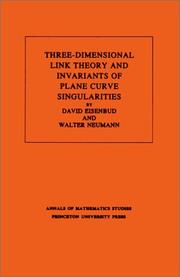
ISBN: 0691083819 0691083800 1400881927 9780691083810 9780691083803 Year: 1985 Volume: 110 Publisher: Princeton Princeton University Press
Abstract | Keywords | Export | Availability | Bookmark
 Loading...
Loading...Choose an application
- Reference Manager
- EndNote
- RefWorks (Direct export to RefWorks)
This book gives a new foundation for the theory of links in 3-space modeled on the modern developmentby Jaco, Shalen, Johannson, Thurston et al. of the theory of 3-manifolds. The basic construction is a method of obtaining any link by "splicing" links of the simplest kinds, namely those whose exteriors are Seifert fibered or hyperbolic. This approach to link theory is particularly attractive since most invariants of links are additive under splicing.Specially distinguished from this viewpoint is the class of links, none of whose splice components is hyperbolic. It includes all links constructed by cabling and connected sums, in particular all links of singularities of complex plane curves. One of the main contributions of this monograph is the calculation of invariants of these classes of links, such as the Alexander polynomials, monodromy, and Seifert forms.
Algebraic geometry --- Differential geometry. Global analysis --- Link theory. --- Curves, Plane. --- SINGULARITIES (Mathematics) --- Curves, Plane --- Invariants --- Link theory --- Singularities (Mathematics) --- Geometry, Algebraic --- Low-dimensional topology --- Piecewise linear topology --- Higher plane curves --- Plane curves --- Invariants. --- 3-sphere. --- Alexander Grothendieck. --- Alexander polynomial. --- Algebraic curve. --- Algebraic equation. --- Algebraic geometry. --- Algebraic surface. --- Algorithm. --- Ambient space. --- Analytic function. --- Approximation. --- Big O notation. --- Call graph. --- Cartesian coordinate system. --- Characteristic polynomial. --- Closed-form expression. --- Cohomology. --- Computation. --- Conjecture. --- Connected sum. --- Contradiction. --- Coprime integers. --- Corollary. --- Curve. --- Cyclic group. --- Determinant. --- Diagram (category theory). --- Diffeomorphism. --- Dimension. --- Disjoint union. --- Eigenvalues and eigenvectors. --- Equation. --- Equivalence class. --- Euler number. --- Existential quantification. --- Exterior (topology). --- Fiber bundle. --- Fibration. --- Foliation. --- Fundamental group. --- Geometry. --- Graph (discrete mathematics). --- Ground field. --- Homeomorphism. --- Homology sphere. --- Identity matrix. --- Integer matrix. --- Intersection form (4-manifold). --- Isolated point. --- Isolated singularity. --- Jordan normal form. --- Knot theory. --- Mathematical induction. --- Monodromy matrix. --- Monodromy. --- N-sphere. --- Natural transformation. --- Newton polygon. --- Newton's method. --- Normal (geometry). --- Notation. --- Pairwise. --- Parametrization. --- Plane curve. --- Polynomial. --- Power series. --- Projective plane. --- Puiseux series. --- Quantity. --- Rational function. --- Resolution of singularities. --- Riemann sphere. --- Riemann surface. --- Root of unity. --- Scientific notation. --- Seifert surface. --- Set (mathematics). --- Sign (mathematics). --- Solid torus. --- Special case. --- Stereographic projection. --- Submanifold. --- Summation. --- Theorem. --- Three-dimensional space (mathematics). --- Topology. --- Torus knot. --- Torus. --- Tubular neighborhood. --- Unit circle. --- Unit vector. --- Unknot. --- Variable (mathematics).
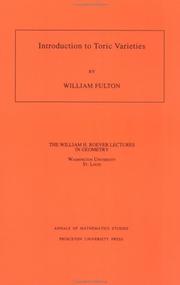
ISBN: 0691000492 0691033323 1400882524 Year: 1993 Publisher: Princeton, N.J. Princeton University Press
Abstract | Keywords | Export | Availability | Bookmark
 Loading...
Loading...Choose an application
- Reference Manager
- EndNote
- RefWorks (Direct export to RefWorks)
Toric varieties are algebraic varieties arising from elementary geometric and combinatorial objects such as convex polytopes in Euclidean space with vertices on lattice points. Since many algebraic geometry notions such as singularities, birational maps, cycles, homology, intersection theory, and Riemann-Roch translate into simple facts about polytopes, toric varieties provide a marvelous source of examples in algebraic geometry. In the other direction, general facts from algebraic geometry have implications for such polytopes, such as to the problem of the number of lattice points they contain. In spite of the fact that toric varieties are very special in the spectrum of all algebraic varieties, they provide a remarkably useful testing ground for general theories.The aim of this mini-course is to develop the foundations of the study of toric varieties, with examples, and describe some of these relations and applications. The text concludes with Stanley's theorem characterizing the numbers of simplicies in each dimension in a convex simplicial polytope. Although some general theorems are quoted without proof, the concrete interpretations via simplicial geometry should make the text accessible to beginners in algebraic geometry.
Algebraic geometry --- Differential geometry. Global analysis --- 512.7 --- Algebraic geometry. Commutative rings and algebras --- Toric varieties. --- 512.7 Algebraic geometry. Commutative rings and algebras --- Toric varieties --- Embeddings, Torus --- Torus embeddings --- Varieties, Toric --- Algebraic varieties --- Addition. --- Affine plane. --- Affine space. --- Affine variety. --- Alexander Grothendieck. --- Alexander duality. --- Algebraic curve. --- Algebraic group. --- Atiyah–Singer index theorem. --- Automorphism. --- Betti number. --- Big O notation. --- Characteristic class. --- Chern class. --- Chow group. --- Codimension. --- Cohomology. --- Combinatorics. --- Commutative property. --- Complete intersection. --- Convex polytope. --- Convex set. --- Coprime integers. --- Cotangent space. --- Dedekind sum. --- Dimension (vector space). --- Dimension. --- Direct proof. --- Discrete valuation ring. --- Discrete valuation. --- Disjoint union. --- Divisor (algebraic geometry). --- Divisor. --- Dual basis. --- Dual space. --- Equation. --- Equivalence class. --- Equivariant K-theory. --- Euler characteristic. --- Exact sequence. --- Explicit formula. --- Facet (geometry). --- Fundamental group. --- Graded ring. --- Grassmannian. --- H-vector. --- Hirzebruch surface. --- Hodge theory. --- Homogeneous coordinates. --- Homomorphism. --- Hypersurface. --- Intersection theory. --- Invertible matrix. --- Invertible sheaf. --- Isoperimetric inequality. --- Lattice (group). --- Leray spectral sequence. --- Limit point. --- Line bundle. --- Line segment. --- Linear subspace. --- Local ring. --- Mathematical induction. --- Mixed volume. --- Moduli space. --- Moment map. --- Monotonic function. --- Natural number. --- Newton polygon. --- Open set. --- Picard group. --- Pick's theorem. --- Polytope. --- Projective space. --- Quadric. --- Quotient space (topology). --- Regular sequence. --- Relative interior. --- Resolution of singularities. --- Restriction (mathematics). --- Resultant. --- Riemann–Roch theorem. --- Serre duality. --- Sign (mathematics). --- Simplex. --- Simplicial complex. --- Simultaneous equations. --- Spectral sequence. --- Subgroup. --- Subset. --- Summation. --- Surjective function. --- Tangent bundle. --- Theorem. --- Topology. --- Toric variety. --- Unit disk. --- Vector space. --- Weil conjecture. --- Zariski topology.
| Listing 1 - 10 of 44 | << page >> |
Sort by
|

 Search
Search Feedback
Feedback About UniCat
About UniCat  Help
Help News
News